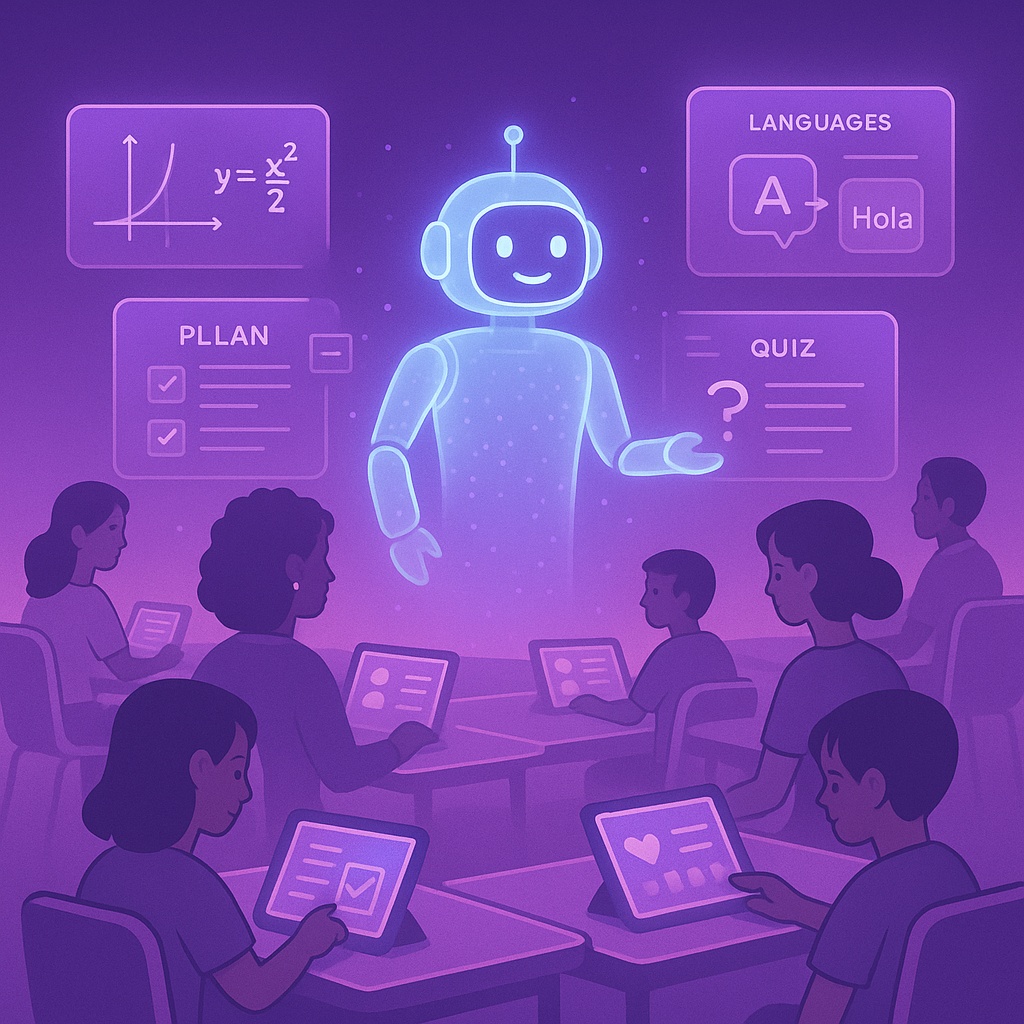🎓 The Future of AI in Education: What's Next for Students and Teachers?
By The AI Heaven

🤖 Artificial intelligence is transforming education in 2025. From personalized tutors to virtual assistants and smart content creation, AI is reshaping how we learn, teach, and think about the classroom.
🎯 Personalized Learning at Scale
AI tools can now adapt lessons to the pace, level, and preferences of each learner. Platforms like ChatGPT Edu and other intelligent tutoring systems offer real-time feedback, helping students overcome obstacles and build understanding in ways traditional classrooms struggle to scale.
Educators can use AI to:
- Identify struggling students early
- Generate differentiated assignments
- Summarize lessons based on classroom discussions
- Recommend enrichment resources tailored to students' learning styles
✅ The result? A learning experience that feels tailor-made for every student.
🧑💻 Virtual Assistants and Interactive Avatars
Educational avatars like Khanmigo (by Khan Academy) and apps like Praktika.ai simulate natural conversation and provide engaging ways to practice languages or problem-solving.
These tools:
- Allow safe environments for practice
- Give students 24/7 access to support
- Promote self-directed learning
- Boost student confidence in a low-pressure environment
Talking to a bot that acts like a language tutor is no longer science fiction — it's happening right now.
🌍 Real-World Example: How Students Use AI Today
Let's take Elena, a 16-year-old high school student in Spain. She uses ChatGPT to:
- Summarize biology chapters in bullet points
- Translate homework questions into English
- Create sample answers before oral exams
- Review key terms with flashcards generated by AI
She's not alone:
Uses Eduaide.ai to plan weekly science lessons and create quizzes based on student progress.
Integrates AI-powered dashboards that track real-time engagement and provide suggestions to teachers mid-lesson.
These concrete implementations show that AI is being woven directly into classrooms around the world.
🏫 AI in the Classroom: The Hybrid Teacher Model
Some schools are testing AI-assisted classrooms, where human educators are paired with AI tools to guide students. In the UK, pilot programs are experimenting with AI guiding students in key subjects while human learning coaches assist with motivation and social-emotional needs.
AI supports:
- Lesson planning
- Real-time assessment
- Automating repetitive tasks (e.g., grading)
- Providing scaffolding for neurodivergent learners
Teachers aren't being replaced — they're being empowered.
🧰 Teachers' Toolkit: How Educators Use AI
Modern teachers are embracing AI in various ways:
Tools like Eduaide.ai help generate warm-ups and exit tickets
Build quizzes from PDFs or notes automatically
Support classroom Q&A with real-time language help
Designed by educators for specific curricula
These tools help reduce prep time and allow teachers to focus on engagement.
📈 Emerging Trends in AI for Education
- Content Generation: AI creates quizzes, lesson plans, summaries
- Assessment Automation: Analyze student performance across assignments
- Adaptive Learning: Adjusts lesson flow based on user behavior
- Multilingual Support: Translate content instantly for diverse classrooms
- Learning Analytics: Provide dashboards with real-time insights into student engagement and understanding
Visual tip: A chart showing AI adoption across countries or benefits per stakeholder (students, teachers, schools) can enhance comprehension here.
📊 What the Research Says (2024-2025)
Sources: UNESCO EdTech Reports 2024, Khan Academy Impact Study, EducationWeek AI Adoption Survey
⚖️ Ethical Concerns and Challenges
As AI spreads, key challenges include:
- 🔐 Data Privacy: How student data is used and stored
- ⚖️ Bias: Ensuring fair and accurate feedback across diverse learners
- 💬 Human Connection: Balancing screen time with human interaction
- 🧩 Equity: Ensuring that under-resourced schools are not left behind in the AI revolution
But there's more to it:
- ⚙️ Transparency: Students and teachers need to understand how AI makes decisions.
- 📚 Education on Ethics: Schools should teach critical thinking about AI, not just how to use it.
- 🌐 Global Responsibility: Developers must ensure tools work in low-resource settings and diverse languages.
Responsible AI in education means involving all stakeholders — students, parents, educators, and developers — in the design and decision-making process.
❓ Frequently Asked Questions (FAQ)
Q: Will AI replace teachers?
A: No — it enhances their role by automating tedious tasks and offering personalized support.
Q: Can AI be trusted to teach children?
A: AI is a helpful assistant, not a substitute for a qualified educator. It must always be used with supervision and ethical guidelines.
Q: Is AI useful in low-tech or rural schools?
A: Yes, many tools now work on mobile phones and offline environments are being developed to ensure global access.
Q: What skills will future teachers need?
A: Digital literacy, AI prompt writing, data interpretation, and ethics awareness are becoming essential.
🚀 What This Means for the Future
Education will become:
- More accessible, with tools that reach remote or underserved students
- More adaptive, responding to student needs in real-time
- More collaborative, as AI helps both teachers and learners thrive
- More data-driven, empowering educators with insight
But thoughtful implementation is key — technology should support the human mission of education, not dominate it.
✅ Final Thoughts
AI is not here to replace teachers. It's here to remove friction from learning, to scale personalized help, and to give educators more time to do what they do best: inspire, connect, and guide.
Education powered by AI is already happening. The question now is: how will we shape it?
💡 What Can You Do Next?
Experiment with ChatGPT or Khanmigo to support your studies or lessons
Check our Tools section for free AI education resources
Talk with fellow educators and students about AI's role in your classroom
Create custom GPTs for education using OpenAI's platform
Let's build the future of learning — together.
Subscribe to The AI Heaven for more insights on AI in education and other cutting-edge technologies.